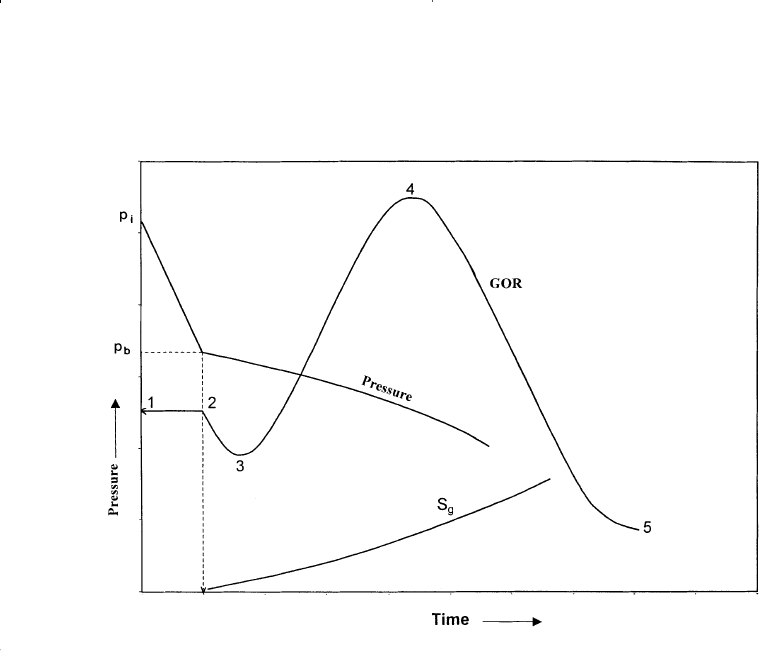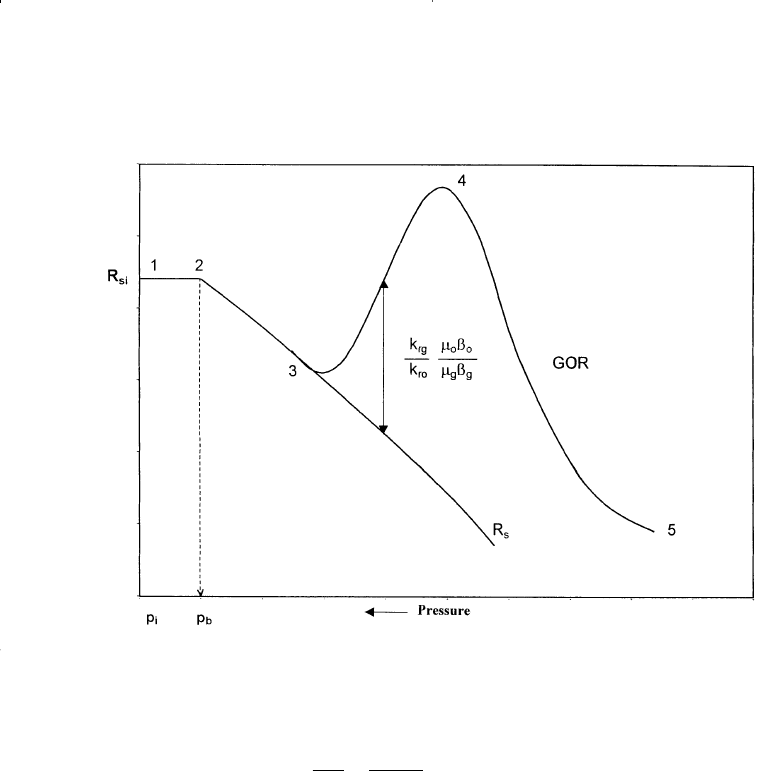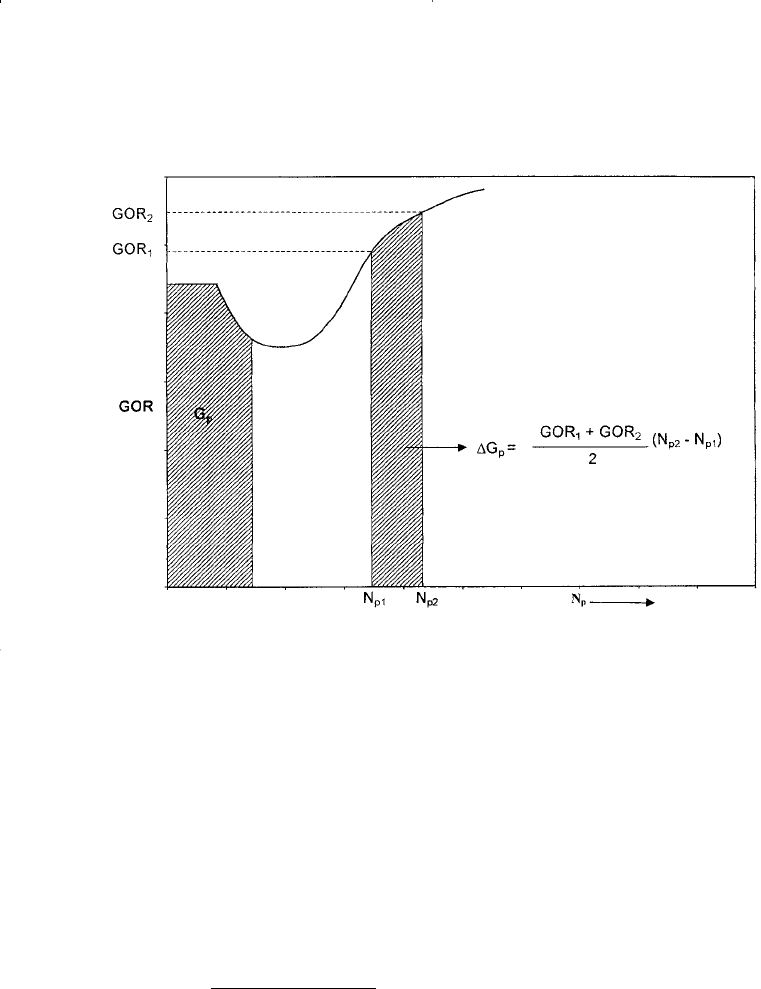Tarek Ahmed. Reservoir engineering handbook
Подождите немного. Документ загружается.


Solution
The calculations can be conveniently performed in following table:
p, psia N
p
, MSTB G
p
, MMscf (N
P
Φ
o
)(G
P
Φ
g
) N, STB
1600 398 38.6 14.52 × 10
6
15.42 × 10
6
29.74 × 10
6
1500 155.8 155.8 22.45 × 10
6
27.85 × 10
6
50.30 × 10
6
1100 803.0 803.0 9.39 × 10
6
40.79 × 10
6
50.18 × 10
6
The above results show that the original oil in place in this reservoir is
approximately 50 MMSTB of oil. The calculation at 1600 psia is a good
example of the sensitivity of such a calculation near the bubble-point
pressure. Since the last two values of the original oil in place agree so
well, the first calculation is probably wrong.
PROBLEMS
1. Given the following data on an oil reservoir:
Oil Aquifer
Geometry circle semi-circle
Encroachment angle — 180°
Radius, ft 4000 80,000
Flow regime semisteady-state unsteady-state
Porosity — 0.20
Thickness, ft — 30
Permeability, md 200 50
Viscosity, cp 1.2 0.36
Original pressure 3800 3800
Current pressure 3600 —
Original volume factor 1.300 1.04
Current volume factor 1.303 1.04
Bubble-point pressure 3000 —
The field has been on production for 1120 days and has produced
800,000 STB of oil and 60,000 STB of water. Water and formation com-
pressibilities are estimated to 3 × 10
−6
and 3.5 ×10
−6
psi
−1
, respectively.
Calculate the original oil in place.
778 Reservoir Engineering Handbook
Reservoir Eng Hndbk Ch 11 2001-10-25 15:59 Page 778

2. The following rock- and fluid-properties data are available on the
Nameless Fields:
Reservoir area = 1000 acres porosity = 10% thickness = 20′
T = 140°F s
wi
= 20%
p
i
= 4000 psi p
b
= 4000 psi
The gas compressibility factor and relative permeability ratio are given
by the following expressions:
z = 0.8 − 0.00002 (p − 4000)
The production history of the field is given below:
4000 psi 3500 psi 3000 psi
µ
o
, cp 1.3 1.25 1.2
µ
g
, cp — 0.0125 0.0120
B
o
, bbl/STB 1.4 1.35 1.30
R
s
, scf/STB — — 450
GOR, scf/STB 600 — 1573
Subsurface information indicates that there is no aquifer and has been
no water production.
Calculate:
a. Remaining oil in place at 3000 psi
b. Cumulative gas produced at 3000 psi
3. The following PVT and production history data are available on an oil
reservoir in West Texas:
Original oil in place = 10 MMSTB
Initial water saturation = 22%
Initial reservoir pressure = 2496 psia
Bubble-point pressure = 2496 psi
Pressure B
o
R
s
B
g
µ
o
µ
g
GOR
psi bbl/STB scf/STB bbl/scf cp cp scf/STB
2496 1.325 650 0.000796 0.906 0.016 650
1498 1.250 486 0.001335 1.373 0.015 1360
1302 1.233 450 0.001616 1.437 0.014 2080
k
k
e
rg
ro
Sg
= 0 00127
17 269
.
.
Oil Recovery Mechanisms and the Material Balance Equation 779
Reservoir Eng Hndbk Ch 11 2001-10-25 15:59 Page 779

The cumulative gas-oil ratio at 1302 psi is recorded at 953 scf/STB.
Calculate:
a. Oil saturation at 1302 psia
b. Volume of the free gas in the reservoir at 1302 psia
c. Relative permeability ratio (k
g
/k
o
) at 1302 psia
4. The Nameless Field is an undersaturated-oil reservoir. The crude oil
system and rock type indicates that the reservoir is highly compress-
ible. The available reservoir and production data are given below:
S
wi
= 0.25 φ=20% Area = 1,000 acres
h = 70′ T = 150°F
Bubble-point pressure = 3500 psia
Original condition Current conditions
Pressure, psi 5000 4500
B
o
, bbl/STB 1.905 1.920
R
s
, scf/STB 700 700
N
P
, MSTB 0 610.9
Calculate the cumulative oil production at 3900 psi. The PVT data
show that the oil formation volume factor is equal to 1.938 bbl/STB at
3900 psia.
5. The following data
2
is available on a gas-cap-drive reservoir:
Pressure N
p
R
p
B
o
R
s
B
g
(psi) (MMSTB) (scf/STB) (RB/STB) (scf/STB) (RB/scf)
3,330 1.2511 510 0.00087
3,150 3.295 1,050 1.2353 477 0.00092
3,000 5.903 1,060 1.2222 450 0.00096
2,850 8.852 1,160 1.2122 425 0.00101
2,700 11.503 1,235 1.2022 401 0.00107
2,550 14.513 1,265 1.1922 375 0.00113
2,400 17.730 1,300 1.1822 352 0.00120
Calculate the initial oil and free gas volumes.
6. The Wildcat Reservoir was discovered in 1980. This reservoir had an
initial reservoir pressure of 3,000 psia, and laboratory data indicated a
780 Reservoir Engineering Handbook
2
Dake, L. P., Fundamentals of Reservoir Engineering, Elsevier Publishing Co., Amster-
dam, 1978.
Reservoir Eng Hndbk Ch 11 2001-10-25 15:59 Page 780

bubble-point pressure of 2,500 psi. The following additional data are
available:
Area = 700 acres
Thickness = 35 ft
Porosity = 20%
Temperature = 150°F
API gravity = 50°
Specific gravity of gas = 0.72
Initial water saturation = 25%
Average isothermal oil compressibility above the bubble point = 18 ×
10
−6
psi
−1
Calculate the volume of oil initially in place at 3,000 psi as expressed
in STB.
REFERENCES
1. Clark, N., Elements of Petroleum Reservoirs. SPE, Dallas, TX 1969.
2. Cole, F., Reservoir Engineering Manual. Gulf Publishing Co., Houston, TX
1969.
3. Craft, B. C., and Hawkins, M. (Revised by Terry, R. E.), Applied Petroleum
Reservoir Engineering, 2nd ed. Englewood Cliffs, NJ: Prentice Hall, 1991.
4. Dake, L. P., Fundamentals of Reservoir Engineering. Amsterdam: Elsevier.
1978.
5. Dake, L., The Practice of Reservoir Engineering, Amsterdam: Elsevier.
1994.
6. Economides, M., and Hill, D., Petroleum Production System. Prentice Hall,
1993.
7. Havlena, D., and Odeh, A. S., “The Material Balance as an Equation of a
Straight Line,” JPT, August 1963, pp. 896–900.
8. Havlena, D., and Odeh, A. S., “The Material Balance as an Equation of a
Straight Line, Part II—Field Cases,” JPT, July 1964, pp. 815–822.
9. Schilthuis, R., “Active Oil and Reservoir Energy,” Trans. AIME, 1936, Vol.
118, p. 33.
10. Steffensen, R., “Solution-Gas-Drive Reservoirs,” Petroleum Engineering
Handbook, Chapter 37. Dallas: SPE, 1992.
11. Tracy, G., “Simplified Form of the MBE,” Trans. AIME, 1955, Vol. 204, pp.
243–246.
12. Van Everdingen, A., and Hurst, W., “The Application of the Laplace Trans-
formation to Flow Problems in Reservoirs,” Trans. AIME, 1949, p. 186.
Oil Recovery Mechanisms and the Material Balance Equation 781
Reservoir Eng Hndbk Ch 11 2001-10-25 15:59 Page 781

782
CHAPTER 12
PREDICTING OIL
RESERVOIR
PERFORMANCE
Most reservoir engineering calculations involve the use of the material
balance equation. Some of the most useful applications of the MBE
require the concurrent use of fluid flow equations, e.g., Darcy’s equation.
Combining the two concepts would enable the engineer to predict the
reservoir future production performance as a function of time. Without
the fluid flow concepts, the MBE simply provides performance as a func-
tion of the average reservoir pressure. Prediction of the reservoir future
performance is ordinarily performed in the following two phases:
Phase 1. Predicting cumulative hydrocarbon production as a function of
declining reservoir pressure. This stage is accomplished without regard to:
• Actual number of wells
• Location of wells
• Production rate of individual wells
• Time required to deplete the reservoir
Phase 2. The second stage of prediction is the time-production phase. In
these calculations, the reservoir performance data, as calculated from
Phase One, are correlated with time. It is necessary in this phase to
account for the number of wells and the productivity of each well.
Reservoir Eng Hndbk Ch 12 2001-10-25 16:04 Page 782

PHASE 1. RESERVOIR PERFORMANCE
PREDICTION METHODS
The material balance equation in its various mathematical forms as
presented in Chapter 11 is designed to provide with estimates of the ini-
tial oil in place N, size of the gas cap m, and water influx W
e
. To use the
MBE to predict the reservoir future performance, it requires two addi-
tional relations:
• Equation of producing (instantaneous) gas-oil ratio
• Equation for relating saturations to cumulative oil production
These auxiliary mathematical expressions are presented as follows:
Instantaneous Gas-Oil Ratio
The produced gas-oil ratio (GOR) at any particular time is the ratio of
the standard cubic feet of total gas being produced at any time to the
stock-tank barrels of oil being produced at that same instant. Hence, the
name instantaneous gas-oil ratio. Equation 6-54 in Chapter 6 describes
the GOR mathematically by the following expression:
where GOR = instantaneous gas-oil ratio, scf/STB
R
s
= gas solubility, scf/STB
k
rg
= relative permeability to gas
k
ro
= relative permeability to oil
B
o
= oil formation volume factor, bbl/STB
B
g
= gas formation volume factor, bbl/scf
µ
o
= oil viscosity, cp
µ
g
= gas viscosity, cp
The instantaneous GOR equation is of fundamental importance in
reservoir analysis. The importance of Equation 12-1 can appropriately be
discussed in conjunction with Figures 12-1 and 12-2.
These illustrations show the history of the gas-oil ratio of a hypotheti-
cal depletion-drive reservoir that is typically characterized by the follow-
ing points:
GOR R
k
k
B
B
s
rg
ro
oo
gg
=+
µ
µ
(12 -1)
Predicting Oil Reservoir Performance 783
Reservoir Eng Hndbk Ch 12 2001-10-25 16:04 Page 783

Point 1. When the reservoir pressure p is above the bubble-point pres-
sure p
b
, there is no free gas in the formation, i.e., k
rg
= 0, and
therefore:
GOR = R
si
= R
sb
(12 - 2)
The gas-oil ratio remains constant at R
si
until the pressure reach-
es the bubble-point pressure at Point 2.
Point 2. As the reservoir pressure declines below p
b
, the gas begins to
evolve from solution and its saturation increases. This free gas,
however, cannot flow until the gas saturation S
g
reaches the criti-
cal gas saturation S
gc
at Point 3. From Point 2 to Point 3, the
instantaneous GOR is described by a decreasing gas solubility as:
GOR = R
s
(12 - 3)
Point 3. At Point 3, the free gas begins to flow with the oil and the val-
ues of GOR are progressively increasing with the declining
reservoir pressure to Point 4. During this pressure decline peri-
od, the GOR is described by Equation 12-1, or:
784 Reservoir Engineering Handbook
Figure 12-1. Characteristics of solution-gas-drive reservoirs.
Reservoir Eng Hndbk Ch 12 2001-10-25 16:04 Page 784

Point 4. At Point 4, the maximum GOR is reached due to the fact that
the supply of gas has reached a maximum and marks the begin-
ning of the blow-down period to Point 5.
Point 5. This point indicates that all the producible free gas has been pro-
duced and the GOR is essentially equal to the gas solubility and
continues to Point 6.
There are three types of gas-oil ratios, all expressed in scf/STB, which
must be clearly distinguished from each other. These are:
• Instantaneous GOR (defined by Equation 12-1)
• Solution GOR
• Cumulative GOR
GOR R
k
k
B
B
s
rg
ro
oo
gg
=+
µ
µ
Predicting Oil Reservoir Performance 785
Figure 12-2. History of GOR and R
s
for a solution-gas-drive reservoir.
Reservoir Eng Hndbk Ch 12 2001-10-25 16:04 Page 785

The solution gas-oil ratio is a PVT property of the crude oil system. It
is commonly referred to as gas solubility and denoted by R
s
. It measures
the tendency of the gas to dissolve in or evolve from the oil with chang-
ing pressures. It should be pointed out that as long as the evolved gas
remains immobile, i.e., gas saturation S
g
is less than the critical gas satu-
ration, the instantaneous GOR is equal to the gas solubility, i.e.:
GOR = R
s
The cumulative gas-oil ratio R
p
, as defined previously in the material
balance equation, should be clearly distinguished from the producing
(instantaneous) gas-oil ratio (GOR). The cumulative gas-oil ratio is
defined as:
or
where R
p
= cumulative gas-oil ratio, scf/STB
G
p
= cumulative gas produced, scf
N
p
= cumulative oil produced, STB
The cumulative gas produced G
p
is related to the instantaneous GOR
and cumulative oil production by the expression:
Equation 12-5 simply indicates that the cumulative gas production at
any time is essentially the area under the curve of the GOR versus N
p
relationship, as shown in Figure 12-3.
G GOR d N
pp
o
N
p
=
∫
( ) (12 - 5)
R
G
N
p
p
p
= (12 - 4)
R
cumulative TOTAL gas produced
cumulative oil produced
p
=
()
786 Reservoir Engineering Handbook
Reservoir Eng Hndbk Ch 12 2001-10-25 16:04 Page 786

The incremental cumulative gas produced ∆G
p
between N
p1
, and N
p2
is then given by:
The above integral can be approximated by using the trapezoidal rule,
to give:
or
∆G
p
= (GOR)
avg
∆N
p
∆G
GOR GOR
NN
ppp
=
+
−
()()
()
12
21
2
∆G GOR d N
p
N
p
N
p
p
=
∫
()
1
2
(12 - 6)
Predicting Oil Reservoir Performance 787
Figure 12-3. Relationship between GOR and G
p
.
Reservoir Eng Hndbk Ch 12 2001-10-25 16:04 Page 787
